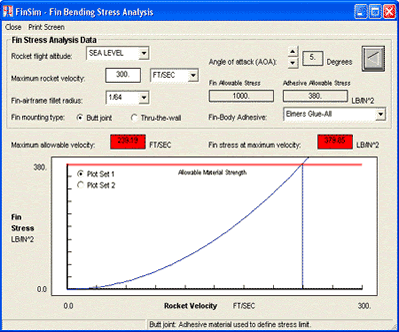| Manufacturer: | AeroRocket  |
The purpose of this review is to put an emphasis on Mr. Cipolla's advice and to suggest that the lower bound be taken more seriously as a means to design fins that will not flutter. There are two technical reasons that support this position, namely model (equation) applicability and the neglect of the natural frequency in plunging. Both result in the reduction of a rather complex problem into a simple relation to predict flutter velocity. These simplifications result in an incremental over-prediction of flutter speed. The more conservative approach of using the 2-dimensional lift-coefficient disguises the effects of these approximations. If I have peaked your interest, then please read on for further explanation. The approach used in FinSim is known as a quasi-steady approximation to predicting flutter speed. This approximation assumes that the frequency of vibration (oscillation) is small relative to the linear flight speed of the rocket. This relationship is often described as a reduced frequency given by the simple equation: Where, The quasi-steady approximation is considered valid when the reduced frequency is small, that is when k.<= 0.1 This is rarely the case for subsonic flow (Mach number less than ~0.8). The quasi-steady approximation is best suited for the prediction of flutter speed in supersonic flow, or for use in design studies where trends are of interest rather than an accurate prediction of flutter speed. The quasi-steady equation for flutter speed in FinSim relates the flutter speed as directly proportional to the natural frequency in torsion (twist) and neglects any effect due to the natural frequency in plunging (bending). Again, this assumption results in an incremental over-prediction of flutter speed. The error can be minor or quite significant, depending on the magnitude of the square of the natural frequency in plunging relative to the magnitude to the square of the natural frequency in torsion. The error tends to increase as fin aspect ratio and taper ratio decrease. If the natural frequency in plunging were accounted for in the quasi-steady approximation, then the flutter speed would be proportional to the square root of the difference in the square of the natural frequencies, that is: The %-error due to this approximation alone is calculated as follows: In conclusion, the additive error of these two approximations could result in a significant over-prediction of the actual flutter speed, particularly if one were to base their calculation on a lift-coefficient corrected for 3-dimensional effects.Aero

 John Cipolla offers a great computer program called FinSim that allows one to do structural, aerodynamic and aeroelastic analysis of rocket fins. Equally impressive is his discussion located on the FinSim Website and the link to a paper describing the details of the fin flutter and divergence method. Mr. Cipolla wisely suggests that when using FinSim to estimate flutter velocity, one should bound the flutter prediction by using the theoretical 2-dimensional lift coefficient (2 pi ) to establish a lower bound and the 3-dimensional lift coefficient to establish an upper bound. Most likely the flutter velocity will fall between these two extremes.
John Cipolla offers a great computer program called FinSim that allows one to do structural, aerodynamic and aeroelastic analysis of rocket fins. Equally impressive is his discussion located on the FinSim Website and the link to a paper describing the details of the fin flutter and divergence method. Mr. Cipolla wisely suggests that when using FinSim to estimate flutter velocity, one should bound the flutter prediction by using the theoretical 2-dimensional lift coefficient (2 pi ) to establish a lower bound and the 3-dimensional lift coefficient to establish an upper bound. Most likely the flutter velocity will fall between these two extremes.![]() Reduced (normalized) frequency of vibration
Reduced (normalized) frequency of vibration![]() Frequency of Vibration, Hz
Frequency of Vibration, Hz![]() Average Chord of Fin, unit-of-length
Average Chord of Fin, unit-of-length![]() Linear Rocket Velocity, unit-of-length per second
Linear Rocket Velocity, unit-of-length per second![]()

 |
 |
J.C. (August 2, 2006)
Sponsored Ads
 |
 |

















J.H.C. (October 16, 2004)